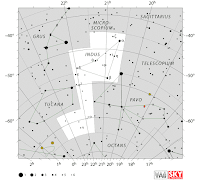I apologize that this is later than my other post and is probably not sufficiently proofed... but it's out the day it was due!
We’re taking a stop today at the letter L in our
A-Z Challenge. As it was with the letter C, there are a host
of constellations that begin with an L.
Three of the most well-known ones are Leo, Libra and Lyra. Among the half dozen not well known ones is
Lynx, which has no bright stars and can only be seen where the sky is truly
black. The elusive nature of the Lynx,
like the wild variety of which I’ve only seen once (in Northern Ontario), made
it worth a mention.
Leo the Lion, is best seen in the northern hemisphere
during the Spring. You can find it under
the Big Dipper. Look for the star
Regulus, which makes up Leo’s front hip.
It is a bright star (the 20th brightest in the sky). The shape of the other stars make out a
lion. This is an old constellation,
existing in mythology long before Ptolemy created his classification of 48 constellations
in the 2nd Century. Leo is
also in the Zodiac, the swath of stars in which the sun travels through the
sky. It is also from this constellation
that the Leonid meteors seem to come (around November 17th each
year). Leo was one of the challenges
that Hercules faced (see the Letter H).
The strong man killed the lion which is now set into the sky.

Lyra is a small constellation located in the northern sky during
summer, between Hercules and Cygnus, on the edge of the Milky Way. The star, Vega, the fourth brightest in the
sky and of a blue color is located at the top of the constellation and an easy
point to make out the rest of the stars (which appears to form a box of which
Vega is a handle) It is often depicted as a stringed musical instrument. According to mythology, Mercury found a shell
along the banks of the Nile, which he noticed had an echo. He decided to attach strings to it, which
when plucked, created a pleasing sound. Apollo
became interested in this instrument and traded his staff (which allowed one to
fly) for it. Apollos then passed the instrument
on to his son, Orpheus. Orpheus married
Eurydice, but she died from a snake bite. Grief stricken, Orpheus headed
underground and charmed Pluto, the god of the underworld, through his music. Pluto agreed to release his wife. The condition
was that she could follow Orpheus from the underworld, but he couldn’t look
back. Like Lot’s wife, Orpheus couldn’t
resist the temptation to make sure his wife was following and when glanced
back, his wife was doomed to remain in Pluto’s realm. Orpheus then traveled around, the Harry Chapin of the day,singing sad love
songs. Many women fell in love with him through
his music. They tried to seduce him, but he would have none of it. Finally, he was killed by some of the
potential lovers that he had rejected. "If you can't love 'em, kill 'em" was their motto. These murdering seductresses threw the lyre into river, but Jupiter sent a vulture to retrieve the instrument. He had it placed safely in the sky.
Libra is another constellation within the Zodiac and is
seen as a set of ancient scales that is used to weighing out goods in a market
place (or the scales of justice as the stars are also sometimes placed in the
hand of Virgo, the goddess of justice). Originally,
these stars were seen as a part of scorpion’s claws, but was broken off from
Scorpius to form this constellation. It
was through this occurred around twelves centuries before Christ, when the
constellation would have been seen with the Autumnal Equinox and the scales
were depicted as weighing out equal time for day and night.
I have been collecting and checking my information from
these post from a collection of books about the stars that I own along with the
internet. However, my main source is
Julius D. W. Staal’s The New Patterns in
the Sky: Myths and Legends of the Stars. The book was originally published
in 1961, but the new version came out in 1988.
It is a delightful book that tells the stories of the stars (this is not
the book to find the constellations, for that I would suggest one of several
field guides to the stars or an “app” on a smart phone.
Although not heavenly bodies, I should mention two other “L’s”:
Longitude and Latitude. These imaginary
lines that dissect our global home have a linkage to the stars. Latitudes run east and west and in the
northern hemisphere can be easily determined by the angle of height the North Star
is above the horizon. If you’re at the pole,
the star would be straight overhead (90 degrees) and at the equator the star
would be right on the horizon (0 degrees).
Longitude was a harder one to determine. They run north and south (and easy way to remember is that these lines are all the same length--hence "Long" unlike latitudes in which the line becomes smaller as they approach the poles). The solution to finding one's longitude involved science, mechanics and politics. First of all, there wasn’t a pole and equator
in which to establish a baseline. And
then there was no “North Star.” Eventually, such a baseline was established running
through Greenwich England and, once timepieces became accurate enough to maintain
time, one could figure out the precise time at a particular site and compare that to
the time in Greenwich to determine the correct longitude. Dava Sobel wrote a fascinating book, titled
Longitude that tells of the politics and
mechanical struggles that led to the determination of one’s location.



















































